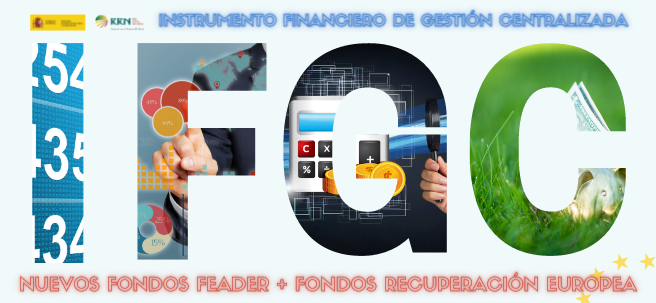
01 de July de 2021
Dinamización rural
07/01/2021. Financial instruments will take on a greater role in the new CAP 2023-2027, according to the draft of the new regulation, which proposes a significant increase in their use.
- The IFGC, promoted by the Ministry of Agriculture, Fisheries and Food, will be able to increase its funds with new EAFRD contributions during the transitional period and with the arrival of the EURI Funds.
- EURI funds are intended to alleviate the effects of the pandemic in rural areas.
- Since its creation, the IFGC has guaranteed nearly 600 loans worth more than €105 million.
Hence, the Centrally Managed Financial Instrument (IFGC), promoted by the Ministry of Agriculture, Fisheries and Food , may also be supported by EAFRD EURI Funds , aimed at alleviating the consequences of the pandemic in rural areas during the period 2021-2022, although the requested projects may be implemented until 2025.
Regional adhesions
Currently, three autonomous communities have joined the IFGC: Castile and León (joined in 2017), Extremadura (joined in 2019), and Galicia (joined in 2020). More autonomous communities are expected to join soon to channel EURI and transitional period funds, with Asturias 's accession being imminent. However, the next period, 2023-2027, is expected to see greater growth in membership due to the growing interest in the use of financial instruments and the positive results achieved so far.
All of these autonomous communities are applying for guaranteed loans co-financed with EAFRD funds for rural development through this tool, which, while centralized and jointly managed, is tailored to the needs of each autonomous community.
What type of support is currently provided to the autonomous communities through the IFGC?
- Investments in agricultural holdings (measure 4.1.)
- Investments in processing/marketing and/or development of agricultural products (measure 4.2.)
- Investments for the creation of businesses by young farmers (Measure 6.1.)
- Investments in forestry technologies and in the processing, mobilization and marketing of forest products (Measure 8.6.)
These supports will be expanded in the new period, which includes new measures financed with financial instruments.
A la carte
Each autonomous community decides and selects the measures to which it wishes to allocate the funds from its Rural Development Programs contributed to the IFGC within the indicated options. The support received through the instrument in the form of a loan guarantee or endorsement can also be combined with the granting of subsidies if the corresponding autonomous community so decides.
Thus, each autonomous region is requesting the IFGC for the rural development aid that best suits its circumstances. These loans, moreover, also allow the granting of subsidies.
The total amount of loans guaranteed by the IFGC since its inception to date amounts to almost 600 loans , which translates into a total amount of loans granted by banking entities of nearly 105 million euros .
What is the IFGC?
The Centrally Managed Financial Instrument (CMI), promoted by the Ministry of Agriculture, Fisheries and Food, is a financial support mechanism, complementary to subsidies, that aims to promote easier access to credit for young people, farmers, ranchers, foresters, agri-food industries, etc. The CMI provides support for viable investments linked to rural areas under improved financing conditions.
To promote this instrument, the National Rural Network has produced this video , which showcases this tool for supporting rural development.
Its creation is included in the National Rural Development Framework 2014-2020 , approved by the European Commission in 2015, which provides for the creation of a financial instrument open to the participation of all autonomous communities that wish to do so, with the aim of grouping the contributions of the participating RDPs under a single management and intermediation structure with financial institutions.
The IFGC is a financial guarantee instrument that provides 80% credit risk coverage for each loan, with a limit of 20% of the portfolio. Thus, the IFGC would guarantee 80% of the risk on a loan-by-loan basis until the maximum guarantee limit rate (20%) is reached, after which the financial intermediary (bank) would assume the entire risk.
One of the characteristics of financial instruments is their repayable nature , since, unlike subsidies, these are aids that are repaid back to the Financial Instrument that previously provided them.
Information exchanges between the stakeholders involved in the process are carried out through a software application developed by MAPA, which is included among the National Rural Network 's activities co-financed by the EAFRD.









